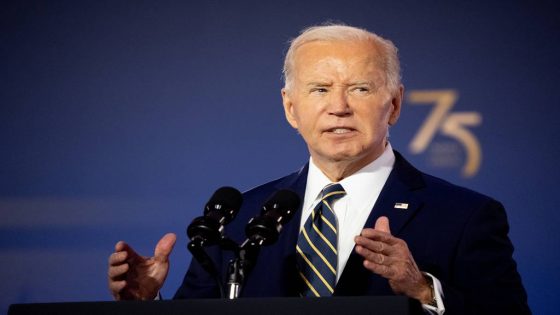After years of failing to meet NATOâs military spending targets, most of the allianceâs 32 members entered the 75th anniversary summit touting a statistic: more than two-thirds now meet the minimum threshold.
It marks a rapid turnaround in a short period dominated by Russiaâs invasion of Ukraine and comes a decade after NATO allies agreed to spend at least 2% of GDP on defense with 20% of that going to major equipment purchases.
Still, some allies on Europeâs eastern flank and Republicans in the U.S. say thatâs not enough. Theyâre pushing to increase the allianceâs defense spending targets beyond 2%, given the war in Ukraine and the risk of an American conflict with China.
None of that stopped President Joe Biden from lauding Washingtonâs progress in getting its NATO allies to shoulder a greater share of the defense burden, a longstanding gripe of U.S. presidents from both parties.
âIn the year 2020, the year I was elected president, only nine NATO allies were spending 2% of their GDP on defense,â Biden said in his opening remarks to kick off the summit on Tuesday. âThis year, 23 will spend at least 2 percent. And some will spend more than that.â
Still, some in the alliance consider that an almost hollow victory. The Wales Summit was 10 years ago, well before Russiaâs full-scale invasion of Ukraine.
The Baltic states in particular are pushing their allies to go beyond the mandatory 2% floor for defense spending as Russia shows no signs of backing down after more than two years of war in Ukraine.
âWeâll start to talk at least about 2.5% as a floor,â Lithuanian Defense Minister Laurynas KasÄiÅ«nas told Defense News, pointing to NATOâs âcapability gaps.â
âWhen we analyze what the countries need to develop in the near-future, for a decade maybe, itâs not even 2.5%. Itâs not even 3%. It should be more if you want more air defense systems, if you want more long-range strike capabilities.â
Tuuli Duneton, Estoniaâs Undersecretary for Defense Policy, praised the 23 countries who now meet the 2% spending target but added âwe should start already the discussions on putting the target for defense spending even higher.â
âWe would support to have the discussion to set in the new target for the next NATO summit in the Hague to either 2.5% or 3% of GDP,â Duneton told reporters.
The U.S. spends roughly 3% of GDP on defense, but the Congressional Budget Office projects that will fall to 2.5% by 2034.
Republicans in the U.S. are also starting to join the Baltic countriesâ call to move the defense spending floor beyond 2% of GDP.
âGiven these dangerous times, the alliance must do more,â Sen. Dan Sullivan, R-Alaska, said in a Tuesday statement. âWe must start working toward a greater defense spending commitment than the current 2% of GDP defense spending benchmark that better reflects this new era of authoritarian aggression we find ourselves in.â
Trump said this year that should he return to the White House, he would allow Russia âto do whatever the hell they wantâ to NATO allies who do not meet the minimum defense spending benchmark.
The former presidentâs allies are calling on NATO allies to replace the U.S. as Ukraineâs primary security guarantor â a task made all the more complicated by years of Europeâs chronic underinvestment in weapons production lines.
âThe things that Europeans most need are not necessarily guys with guns, as important as they are, but lift, logistics, C4ISR, long-range munitions, air defense, but those are exactly the things that are most needed in the Pacific and are most difficult to reconstitute,â Bridge Colby, Trumpâs former assistant secretary of defense for strategy, said Tuesday at the Heritage Foundation.
âThe best way to manage the situation is to be practical and candid with our European allies and say âhereâs what we can provide.â And this is what Iâve said to the Europeans is âweâre going to have to withhold some of these key capabilities.â
Collin Meisel, the associate director of geopolitical analysis at the University of Denverâs Frederick S. Pardee Center for International Futures, cautioned âitâs going to take years for the European countries to make up that shortfall and be able to provide adequate support for Ukraine.â
âIf the U.S. pulls back its materiel support of Ukraine, then Ukraine is going to be in pretty rough shape.â
He also noted that when Ukraine military aid is framed as a percentage of GDP, the U.S. ranks far below multiple European countries, including countries like the Netherlands that have not met NATOâs 2% of GDP benchmark for overall defense spending.
And the spending targets themselves donât guarantee a ready military.
âGreece is the poster child for this,â said John Deni, a former political adviser to U.S. military leaders in Europe.
Athens has long spent more than 2% on defense, he noted, but much of it goes to areas that donât create a strong force, such as personnel and pensions.
âItâs a jobs program,â Deni said.
The 2% and 20% thresholds are the only public thresholds â affirmed as a floor, rather than a ceiling in the 2022 communique in Vilnius, Lithuania.
NATO has 11 private metrics to measure burden sharing, which help assess the readiness of each force, Deni said. Itâs also working to finalize regional defense and deterrence plans that will in part guide procurement decisions for member states. Proponents of increasing the 2% benchmark hope these regional plans will also grow military spending.
âItâs not only the percentage itself that matters, but taking into account that NATO military authorities have been assessing based on the regional plans: all military requirements for defense forces and capabilitiesâ said Estoniaâs Duneton. âThe increased defense spending is most of all necessary for us to be able to deliver on those critical capabilities.â
Bryant Harris is the Congress reporter for Defense News. He has covered U.S. foreign policy, national security, international affairs and politics in Washington since 2014. He has also written for Foreign Policy, Al-Monitor, Al Jazeera English and IPS News.
Noah Robertson is the Pentagon reporter at Defense News. He previously covered national security for the Christian Science Monitor. He holds a bachelorâs degree in English and government from the College of William & Mary in his hometown of Williamsburg, Virginia.
Source Agencies



